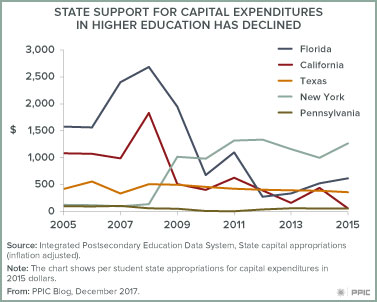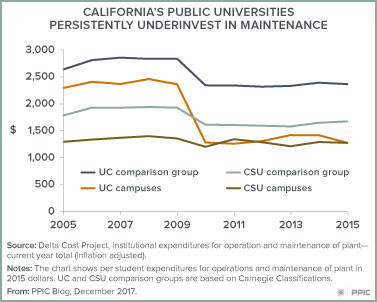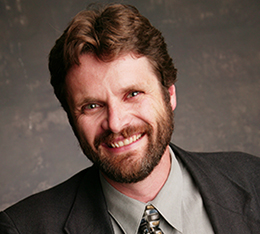PPIC has documented California’s need to increase the number of resident college graduates to meet the economy’s future needs. While the state’s public higher education systems are taking steps to increase the number of students who complete their degrees in a timely manner, these improvements alone will not fill the gap. At some point, the UC and CSU systems will have to expand their capacity, and such an expansion is likely to require long-term capital investment in buildings, technology, and campus infrastructure.
 It is important to note that capital investment encompasses more than new classrooms or dormitories. Earlier this week, the College Futures Foundation released a report by Patrick Lenz in which the California Community Colleges, the University of California (UC), and the California State University (CSU) estimate that they will need a combined $47.2 billion to modernize and maintain their facilities in the next five years alone. Their needs include ensuring the safety and accessibility of aging buildings and investment in the less visible systems—heating, cooling, electrical, and water—that enable a campus to function.
It is important to note that capital investment encompasses more than new classrooms or dormitories. Earlier this week, the College Futures Foundation released a report by Patrick Lenz in which the California Community Colleges, the University of California (UC), and the California State University (CSU) estimate that they will need a combined $47.2 billion to modernize and maintain their facilities in the next five years alone. Their needs include ensuring the safety and accessibility of aging buildings and investment in the less visible systems—heating, cooling, electrical, and water—that enable a campus to function.
A look at some historical data suggests that economic pressures and policy decisions have led California to underinvest in higher education infrastructure over the past decade compared to four other large states. From 2005 to 2015, the period for which we have data, state support for capital investment in both California and Florida dropped sharply as a consequence of the Great Recession. Interestingly, New York increased its support, while support in Pennsylvania and Texas stayed the same.
 In 2000, California voters approved Proposition 39, which makes it easier for community colleges to pass bond measures. Since then, local community college districts have been relatively successful in funding their capital needs. The state’s four-year universities, however, face a different situation. To compare how much UC and CSU spent (per student) on maintaining and operating their campuses between 2005 and 2015, we separated and compared each system to a nationwide group of similar institutions. As the state cut its investment in higher education infrastructure, UC cut its infrastructure spending dramatically, while CSU’s spending remained relatively constant. But average maintenance spending by both systems was significantly below that of their peers.
In 2000, California voters approved Proposition 39, which makes it easier for community colleges to pass bond measures. Since then, local community college districts have been relatively successful in funding their capital needs. The state’s four-year universities, however, face a different situation. To compare how much UC and CSU spent (per student) on maintaining and operating their campuses between 2005 and 2015, we separated and compared each system to a nationwide group of similar institutions. As the state cut its investment in higher education infrastructure, UC cut its infrastructure spending dramatically, while CSU’s spending remained relatively constant. But average maintenance spending by both systems was significantly below that of their peers.
These comparisons suggest that California has been systematically underinvesting in its higher education infrastructure, at least at its four-year public universities. Even if California were not facing a degree gap, it could benefit from rethinking its higher education capital finance strategy. But a new approach becomes imperative when one considers that larger shares of high school graduates are expected to complete the a–g requirements and that many of those students will seek admission to UC and CSU. Efforts by the state’s community colleges to increase the number of students who transfer to four-year institutions will also heighten the need to expand capacity, necessitating further capital investment.
Over the coming months, PPIC will be focusing on capital finance, a key component in maintaining access for all students and producing an educated workforce. We hope to inform state decision making in this critical area.
Visit the PPIC Higher Education Center




